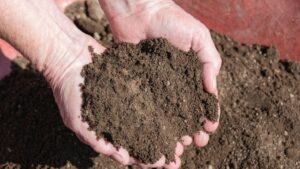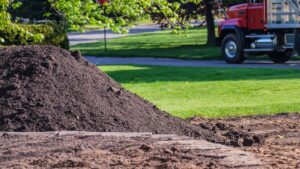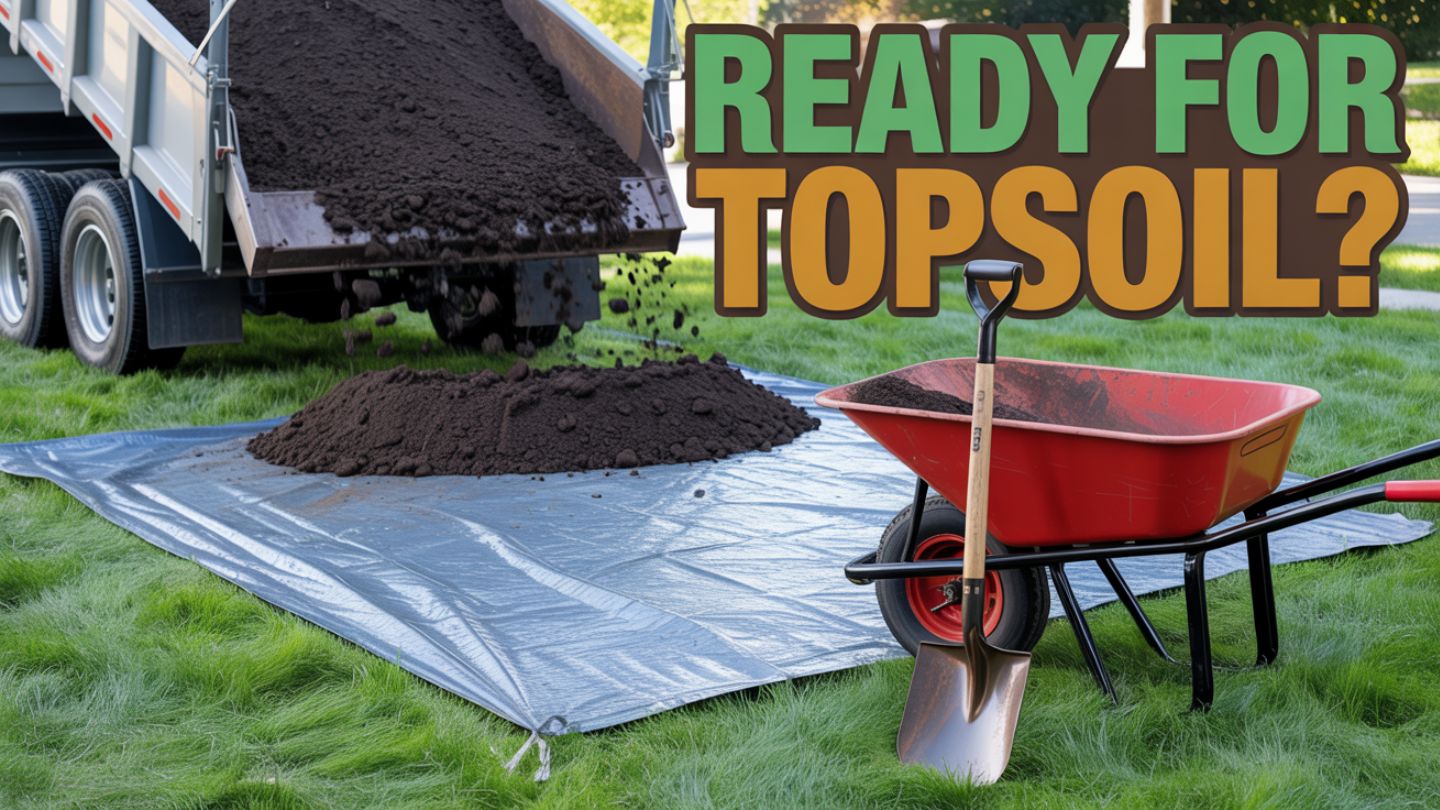Knowing how to prepare your yard for topsoil delivery ensures a smooth and hassle-free process. This blog will walk you through assessing soil requirements, clearing and marking the delivery area, and preparing the yard. Following these steps will help you avoid common pitfalls and get the most out of your topsoil.
Key Takeaways
- Assess your yard’s needs by conducting soil tests and calculating the required volume of topsoil for optimal growth.
- Clear the delivery area and ensure accessibility for the delivery truck to facilitate a smooth topsoil drop-off process.
- Post-delivery care, including proper watering and adding organic matter, is essential for maintaining a healthy lawn after topsoil application.
Assess Your Yard’s Needs
Before arranging a topsoil delivery, it’s important to hire a professional service to ensure your landscaping or gardening project is handled efficiently and effectively. A professional team has the expertise to assess your yard’s specific needs, determine the right type of topsoil for your project, and calculate the exact amount required to avoid waste or shortages.
Why Hire a Professional?
Professionals can evaluate your existing soil conditions, including pH levels, nutrient content, and soil structure, to recommend the best topsoil blend for your garden or lawn. They understand how different plants and grass types thrive in specific soil environments and can customize the delivery to meet those needs.
Additionally, professional services not only handle the delivery but can also assist with spreading and leveling the topsoil to ensure even coverage and optimal integration with your existing soil. This saves you time and ensures that the topsoil is applied correctly for long-term success.
Benefits of Professional Topsoil Delivery
- Expert Recommendations: Get tailored advice on the best topsoil type for your project.
- Accurate Volume Calculation: Avoid over-ordering or under-ordering by relying on precise measurements from professionals.
- Convenient Delivery: Professionals handle logistics, ensuring timely and hassle-free delivery.
- Quality Assurance: High-quality topsoil is sourced to meet your landscaping needs.
- Time and Effort Saved: Skip the manual labor and let experts manage the process.
Hiring a professional topsoil delivery service ensures your garden or lawn receives the best possible start, promoting healthy growth and creating a lush, vibrant landscape without the hassle of doing it yourself.
Clear the Delivery Area
Clearing the delivery area ensures a smooth topsoil delivery process. Key steps include:
- Removing any obstacles like debris, rocks, or vehicles from the designated drop zone.
- Facilitating easy access for the delivery truck.
- Preventing any potential damage to your property during the delivery.
A debris-free delivery zone smooths the process and helps avoid delays and complications. Proper preparation ensures your screened topsoil is placed exactly where needed, ready for immediate use, free of dirt.
Marking the Drop Zone
Clearly marking the drop zone for topsoil delivery prevents confusion. Using visible markers like stakes, cones, or flags can define the exact spot where the topsoil should be placed. Sidewalk chalk is another effective method for indicating the drop zone, ensuring clarity for both you and the delivery driver.
Marking the drop zone reduces the risk of misplaced topsoil, saving time and effort during spreading. This attention to detail ensures the delivery goes smoothly, and the topsoil is precisely where you need it for your gardening or landscaping projects.
Ensuring Accessibility
Ensuring delivery truck accessibility is crucial for a successful topsoil drop-off. Delivery trucks usually require at least 9 feet in width and 11 feet in height clearance to navigate residential properties safely. Check for any low branches, overhead wires, or other obstacles that might obstruct the truck’s path.
Clearing the delivery area and considering the truck’s dimensions guarantees easy access without property damage. Proper accessibility planning ensures that the topsoil can be delivered efficiently and without any hitches, allowing you to proceed with your landscaping projects smoothly.
Preparing the Yard
Proper yard preparation before receiving and applying topsoil involves:
- Addressing uneven areas and drainage issues to ensure a healthy and visually appealing lawn.
- Resolving soil compression problems that can cause uneven landscapes and drainage issues.
- Removing any weeds or debris from the yard.
Compacting and leveling the soil at each stage ensures long-term durability and health of your lawn. Thoroughly preparing your yard creates a solid foundation for topsoil application, promoting healthy growth and a beautiful landscape.
Receiving and Spreading Topsoil

Receiving and spreading topsoil involves critical steps for effective application. On delivery day, skilled drivers deliver topsoil directly to your site using specialized equipment, including a broadcast spreader, for efficient placement. Trucks that can maneuver in tight spaces are used, ensuring smooth delivery even in challenging areas.
Once delivered, spreading the topsoil evenly is crucial. Tools like long rakes and grading tools help ensure accuracy during application. Apply the soil mixture in layers, leveling and compacting to maintain consistency across the lawn. This method promotes healthy growth and prevents future settling issues. Understanding how much topsoil you need for a healthy landscape project helps ensure you apply the right amount, providing plants with sufficient nutrients and optimal root support for vigorous growth.
Spreading the Topsoil
Properly spreading topsoil is crucial for achieving a healthy and level garden or lawn. To do this effectively:
- Utilize tools such as long rakes for effective application.
- Make use of grading tools to ensure precision.
- Apply the topsoil in thin layers.
- Level and compact the soil to avoid air pockets and ensure even coverage.
Consistency is key; conduct repeated assessments to maintain a level surface across the entire area. This thorough approach ensures that your gardens, garden beds, or lawn can thrive, providing a solid foundation on the ground for healthy growth and a beautiful flower bed landscape.
Post-Delivery Care

Post-delivery care is crucial for maintaining a healthy garden or lawn after topsoil application. Mowing, watering, and aerating are essential maintenance tasks to keep your yard in top condition. Limiting foot traffic on freshly leveled sections helps prevent soil compaction and damage. Proper lawn care is vital during this period.
Topdressing with organic matter enhances soil quality by adding nutrients and improving structure. Maintaining good soil moisture levels is vital for plant health, ensuring new topsoil integrates well with existing layers.
Watering and Settling
Daily watering of newly applied topsoil is crucial for integration with existing soil layers. This process supports the settling of the soil, ensuring it becomes a cohesive part of your yard. Keep the soil moist enough to form clumps when squeezed, indicating it is ready for planting.
Proper moisture levels help retain nutrients and support healthy growth, ensuring your plants and grass thrive in healthy gardens. By focusing on watering and settling, you create an optimal environment for your garden or lawn to flourish, promoting strong roots and root systems.
Adding Organic Matter
Adding organic matter enhances topsoil quality and structure. Topsoil and compost, made from decaying plant or animal matter, enrich the soil with nutrients and improve its ability to retain moisture. This organic material acts as a natural fertilizer, aiding in the healthy growth of your plants. To further enhance soil quality, you can add organic matter.
Incorporating compost and organic materials into topsoil enhances seed-to-soil contact during lawn recovery and planting. By adding organic matter, you ensure your soil remains fertile and well-structured, promoting long-term garden health.
Final Thoughts
Preparing your yard for topsoil delivery involves several crucial steps, from assessing your yard’s needs to conducting soil tests and calculating the right amount of topsoil. Clearing the delivery area and ensuring accessibility are vital for a smooth delivery process, while proper yard preparation, including addressing drainage problems and removing weeds and debris, sets the foundation for a healthy garden or lawn.
Scheduling your topsoil delivery in Milton with Mulch Pros, receiving and spreading the topsoil correctly, and providing post-delivery care, including watering and adding organic matter, ensures your landscaping projects are successful. Choosing Mulch Pros for your topsoil needs guarantees high-quality products and exceptional service, making your gardening and landscaping endeavors easier and more efficient. Take the first step towards a thriving landscape by partnering with us for your topsoil delivery needs.
Frequently Asked Questions
What is topsoil, and why is it important?
Topsoil is the uppermost layer of soil, rich in organic matter and nutrients essential for healthy plant growth. It provides a fertile base for gardens, lawns, and landscaping projects, ensuring plants get the nutrients they need to thrive.
How much topsoil is needed for a yard or garden?
This depends on the area you want to cover and the desired depth of topsoil. A common formula is: (Length x Width x Depth) ÷ 27 to calculate cubic yards. Typically, 4-6 inches of topsoil is recommended for gardens and lawns.
What should I do to prepare for topsoil delivery?
You should assess your yard’s needs, clear the delivery area of obstacles, mark the drop zone, and ensure accessibility for the delivery truck. Proper preparation ensures a smooth delivery process and prevents delays.
Can topsoil help fix drainage issues in my yard?
Yes, topsoil can help address minor drainage issues by leveling low spots and improving soil structure. However, severe drainage problems may require additional solutions like regrading or installing drainage systems.


